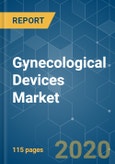An increase in gynecological disorders, such as ovarian cancer, cervical cancer, uterine cancer, vaginal cancer, and vulvar cancer, is driving the market for gynecological devices across the world. The American Cancer Society states that the average age of endometrial cancer diagnosis in women is 60, whereas it isn’t common amongst women below the age of 45. In addition, WHO suggests a routine endometrial ablation procedure should be performed for women above the age of 35, in order to avoid the risks associated with endometrial cancer. Obesity, diabetes, and PCOS patients are more susceptible to endometrial cancer at the ages of 18 to 35 and require endometrial biopsy. The World Health Organization has stated that approximately, 90% of deaths from cervical cancer occur in low- and middle-income countries. The high mortality rate from cancer could be reduced through a comprehensive approach that includes prevention, early diagnosis, effective screening and treatment programs. This, in turn, leads to high demand for gynecological devices globally.
Key Market Trends
Endometrial Ablation Devices Segment is Expected to Show Better Growth Rates during the Forecast Years
Based on product type, the gynecological devices market is segmented into gynecological endoscopy devices, endometrial ablation devices, contraceptive devices, diagnostic imaging systems, fluid management systems, and other products.
The growth of the endometrial ablation devices segment is mainly attributed to the rising burden of cancer and the rising adoption of these devices due to their ease of use and convenience. Endometrial ablation is a type of minimally invasive procedure for the treatment of heavy menstrual bleeding. In addition, endometrial ablation offers several advantages over the other surgeries such as shorter procedure time, faster recovery, and lower pain. Hence, owing to the aforementioned factors, along with the rising adoption of endometrial ablation devices, the segment is expected to witness rapid growth over the forecast period.
North America holds the Largest Share in the Gynecological Devices Market
The North American region holds the largest share of the gynecological gevices market, due to the increasing burden of cancer, the strong presence of device manufacturers, and technological advancements. According to the American Cancer Society, in 2019, an estimated 1,762,450 new cancer cases were diagnosed in the United States. Among all the cancers, there is a major concern for cervical cancer which is growing rapidly in American women. This rising number of cancer is augmentin the demand for the gynecology devices across the country. Additionally, other factors such as rising awareness among women, increasing prevalence of gynecological disorders and well-established healthcare infrastructure are expected to drive the growth of the Gynecological Devices Market in the forecast period.
Competitive Landscape
The market studied is moderately competitive, and there are several global companies that are operating in this market. The major players in the gynecological devices market are Boston Scientific Corporation, Hologic Inc., Johnson & Johnson, Karl Storz SE & Co. KG, Medtronic PLC, Olympus Corporation, Richard Wolf GmbH, Stryker Corporation, and The Cooper Companies Inc.
Reasons to Purchase this report:
Key Market Trends
Endometrial Ablation Devices Segment is Expected to Show Better Growth Rates during the Forecast Years
Based on product type, the gynecological devices market is segmented into gynecological endoscopy devices, endometrial ablation devices, contraceptive devices, diagnostic imaging systems, fluid management systems, and other products.
The growth of the endometrial ablation devices segment is mainly attributed to the rising burden of cancer and the rising adoption of these devices due to their ease of use and convenience. Endometrial ablation is a type of minimally invasive procedure for the treatment of heavy menstrual bleeding. In addition, endometrial ablation offers several advantages over the other surgeries such as shorter procedure time, faster recovery, and lower pain. Hence, owing to the aforementioned factors, along with the rising adoption of endometrial ablation devices, the segment is expected to witness rapid growth over the forecast period.
North America holds the Largest Share in the Gynecological Devices Market
The North American region holds the largest share of the gynecological gevices market, due to the increasing burden of cancer, the strong presence of device manufacturers, and technological advancements. According to the American Cancer Society, in 2019, an estimated 1,762,450 new cancer cases were diagnosed in the United States. Among all the cancers, there is a major concern for cervical cancer which is growing rapidly in American women. This rising number of cancer is augmentin the demand for the gynecology devices across the country. Additionally, other factors such as rising awareness among women, increasing prevalence of gynecological disorders and well-established healthcare infrastructure are expected to drive the growth of the Gynecological Devices Market in the forecast period.
Competitive Landscape
The market studied is moderately competitive, and there are several global companies that are operating in this market. The major players in the gynecological devices market are Boston Scientific Corporation, Hologic Inc., Johnson & Johnson, Karl Storz SE & Co. KG, Medtronic PLC, Olympus Corporation, Richard Wolf GmbH, Stryker Corporation, and The Cooper Companies Inc.
Reasons to Purchase this report:
- The market estimate (ME) sheet in Excel format
- 3 months of analyst support
Table of Contents
1 INTRODUCTION
4 MARKET DYNAMICS
5 MARKET SEGMENTATION
6 COMPETITIVE LANDSCAPE
Companies Mentioned (Partial List)
A selection of companies mentioned in this report includes, but is not limited to:
- Boston Scientific Corporation
- Hologic Inc.
- Johnson & Johnson
- Karl Storz SE & Co. KG
- Medtronic PLC
- Olympus Corporation
- Richard Wolf GmbH
- Stryker Corporation
- The Cooper Companies Inc.
Methodology

LOADING...








